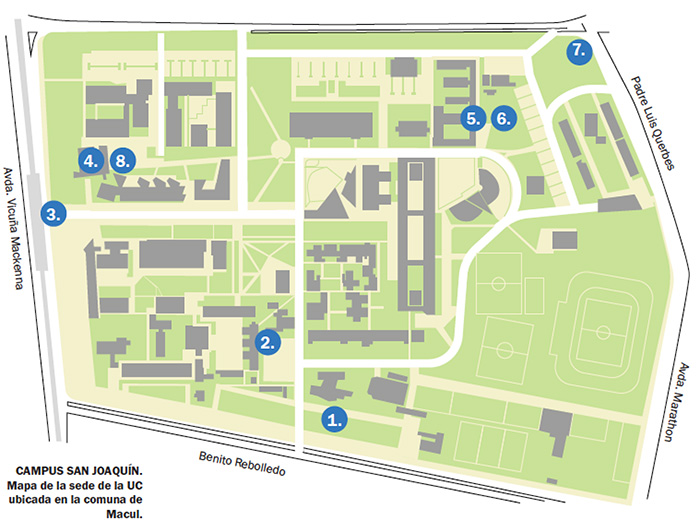
San Joaquín Campus Will Be Chile's First Smart City at Scale
Eight projects have been enabled in their initial phase to cover four critical areas: environment, mobility, security, and enabling resources, for carrying out technological transformations on the San Joaquín Campus. The intention is to then replicate these projects in various municipalities to move towards a “smart Santiago” and improve the quality of life of its residents.

photo_camera The project, which will turn UC Chile's San Joaquín campus into the country's first smart city, will implement 5G-enabled technology solutions to improve people's well-being. The idea is to test different technologies that can then be implemented by municipalities. (Photo: iStock Photo)
What is a smart city? For the Inter-American Development Bank, a smart city “is one which puts people at the center of development, incorporates information technology and communication in urban management, and uses these elements as tools to stimulate the creation of an efficient government that includes processes of collaborative planning and citizen participation.”
Building upon this concept, the country's initial at-scale smart city will be developed at the UC Chile's San Joaquín Campus from 2022 to 2023.
The initiative is led by a partnership between Lab Claro-UC 5G Innovation Centre and “Sé Santiago,” a strategic program of CORFO Metropolitano and País Digital Foundation.
The project seeks to implement 5G-enabled technology solutions with the aim of improving people's well-being. The idea is to test different technologies that can then be implemented by municipalities.
The implementation work has started, with eight technologies already deployed on campus (explained below), in areas such as environment, mobility, and security.
From the very beginning, it was clear the "Smart City at Scale" project was going to be challenging. But despite its complexity, as Francisco Pizarro, deputy director of R&D with Industry at the UC Chile Anacleto Angelini Innovation Centre, explained:
“We had three key items to put it into practice: a demonstration area for regional governments to witness the application of these technologies, a prototyping space to develop solutions in academia, and a meeting point to collaborate with entrepreneurs on open innovation models.”
Consequently, the San Joaquín campus, its experts, and the network of entrepreneurs were mobilized, along with the capability to manage the task of providing meaningful solutions that enhance the residents' quality of life.
“That is the goal of smart cities,” said Pizzaro.
This project also includes the deployment of infrastructure that combines technologies such as fiber optics, 5G, 5G standalone and IoT (Internet of Things), all of which are key elements for migrating from traditional management to smart cities.
Finally, the project is supported by Nokia and Qualcomm.
A Frontier Initiative
The initiative addresses the current and future challenges posed by the development of urban centers and the efficient use of technology, according to University President Ignacio Sánchez, by developing scalable proofs of concept that are enabling technologies that offer better coordination, lower costs, and, most importantly, better territorial management.
When the initiative was announced in August 2022, the President emphasized the “importance of cooperation between academia, industry, and the public sector to benefit civil society, which is a top priority for UC Chile.”
The partnership will move into a second phase in 2023, in which it will broaden its scope to encompass additional areas, including energy, lighting, waste management, entertainment, education, water management, and economics.
Technologies for a Smart City at Scale
The following are the eight technological solutions that have already been implemented at the San Joaquín Campus.

Security Technologies
1. WCS
WCS is a video analytics technology that provides intelligent data to enhance physical security in various settings, including streets, businesses, municipalities, and factories. At the San Joaquín Campus, it will be integrated with the campus's closed-circuit cameras, allowing for real-time monitoring and immediate alerts in the event of any unusual activity or security threat.
2. Smert
This solution aims to collect crucial emergency response information and display it as a QR code at the entrance of buildings. This enables emergency teams, like firefighters, to quickly access and visualize the map of the facilities on campus and address emergencies in a timely and effective manner.
3. Juganu/Omniflow
This lighting model was developed in Portugal and is a self-sustainable solution that uses wind and photovoltaic energy. These smart lights offer real-time video analytics and network coverage for people passing by. They also include a floodlight with environmental sensors and artificial intelligence that can detect movement, optimize traffic, identify distress signals, monitor suspicious activity, and measure population density.
Environment

4. IOTree
This solution involves the integration of high-resolution environmental indicators into urban ecosystem monitoring by using multispectral imaging technology. This will allow for the detection and tracking of environmental health indicators, such as the quality of photosynthesis or diseases in campus trees.
5. BeeWaze
By monitoring environmental conditions both inside and outside beehives, including temperature, humidity, and weight, this initiative generates forecasts and historical data to help beekeepers reduce bee mortality and increase the productivity of their apiaries.
6. SmartFarming
This is an agriculture solution that involves a soil monitoring station for plants to control various data points, including temperature, humidity, acidity, and wind, among others.
Mobility
7. UrbeTrack Project
This 100% digital platform, founded in Argentina in 2007, focuses on traceability and logistics. Its main objective is to assist municipalities in managing and coordinating work plans in public spaces, with the aim of increasing resource efficiency. The platform also facilitates waste collection management and provides real-time geolocation and traceability information for vehicle fleets.
8. Geodata
This system projects flows of people and cars using anonymous data collected from individuals connecting to the cellular antenna network. The tool will continuously analyze all visits to the San Joaquín Campus, allowing campus authorities to make informed decisions about infrastructure and resource allocation. Additionally, citizens can use the tool to plan their routes more efficiently.


